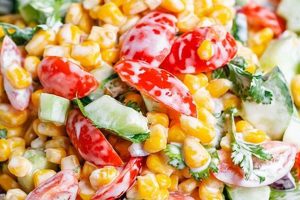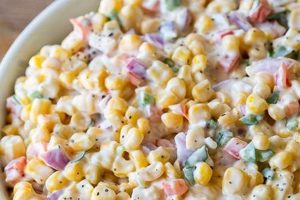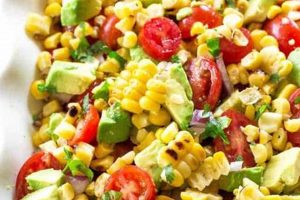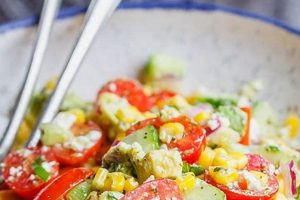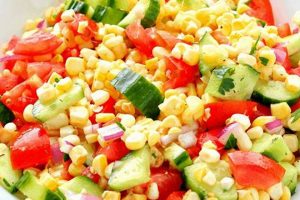Summery mixtures of kernels cut from the cob and ripe, juicy tomatoes form the foundation of a refreshing and versatile dish. Variations abound, incorporating other fresh produce like onions, cucumbers, peppers, or avocado. Dressings range from simple vinaigrettes to creamy emulsions, often highlighting herbs like basil or cilantro. Examples include classic combinations with a light vinaigrette, Southwestern-inspired versions with black beans and lime, or Mediterranean variations with feta cheese and olives.
These salads offer nutritional benefits, providing vitamins, minerals, and fiber. Their adaptability makes them suitable for barbecues, picnics, potlucks, or light lunches. Historically, such combinations likely became popular as seasonal ingredients became readily available during summer harvests. The simplicity of preparation further enhanced their appeal. Fresh, local ingredients contribute to optimal flavor and nutritional value.
The following sections will explore specific recipe variations, offering detailed instructions, tips for selecting the best ingredients, and suggestions for creative presentation. Nutritional information and potential health benefits will also be discussed.
Tips for Creating Exceptional Corn and Tomato Salads
Achieving optimal flavor and texture requires attention to detail throughout the preparation process. The following tips offer guidance for creating exceptional salads.
Tip 1: Ingredient Selection: Ripe, in-season produce yields the best flavor. Select sweet corn with plump, milky kernels and firm, blemish-free tomatoes. Consider heirloom varieties for enhanced flavor profiles and visual appeal.
Tip 2: Corn Preparation: Several methods exist for removing kernels from the cob. Stand the cob upright in a shallow bowl and use a sharp knife to slice downwards. Alternatively, a specialized corn stripper tool can streamline the process.
Tip 3: Tomato Preparation: Dice tomatoes uniformly for even distribution throughout the salad. Remove excess seeds and pulp for a less watery consistency, particularly if using juicy varieties.
Tip 4: Balancing Flavors: Acidity complements the sweetness of corn and tomatoes. Vinegar-based dressings, a squeeze of lime juice, or the addition of chopped red onion provide necessary balance.
Tip 5: Enhancing Texture: Introduce textural contrast through additions like chopped cucumber, bell pepper, or crumbled feta cheese. Toasted nuts or seeds add crunch.
Tip 6: Dressing Application: Dress the salad shortly before serving to prevent the vegetables from becoming soggy. Start with a small amount of dressing and add more as needed.
Tip 7: Herb and Spice Integration: Fresh herbs like basil, cilantro, or parsley enhance flavor complexity. A pinch of red pepper flakes adds subtle heat.
By following these guidelines, one can create vibrant and flavorful salads that showcase the best of summer’s bounty. Proper preparation techniques elevate both taste and presentation.
These tips provide a foundation for culinary exploration. The following section offers a collection of diverse recipes showcasing the versatility of these core ingredients.
1. Fresh, High-Quality Ingredients
The success of any corn and tomato salad hinges on the quality of its primary components. Fresh, ripe produce elevates the dish from simple to exceptional. Selecting superior ingredients ensures optimal flavor, texture, and overall enjoyment. This section explores the critical role of ingredient quality in crafting a truly memorable salad.
- Seasonality
Utilizing in-season produce maximizes flavor and nutritional value. Summer harvests yield the sweetest corn and most flavorful tomatoes. Locally sourced ingredients, when available, further enhance both taste and environmental sustainability. A salad made with peak-season produce will inherently possess a vibrancy lacking in dishes prepared with out-of-season alternatives.
- Ripeness
Optimal ripeness is crucial for both corn and tomatoes. Corn should have plump, milky kernels, while tomatoes should exhibit vibrant color and yield slightly to gentle pressure. Underripe or overripe produce negatively impacts flavor and texture. For instance, a mealy tomato will detract from the overall salad experience.
- Sourcing
Farmers’ markets or local farm stands often offer superior produce compared to supermarkets. These sources frequently prioritize sustainable growing practices and offer a wider variety of heirloom cultivars. Heirloom tomatoes, with their diverse flavors and colors, contribute complexity and visual appeal. Supporting local agriculture strengthens community food systems.
- Storage
Proper storage techniques maintain freshness and prevent premature spoilage. Corn should be refrigerated in its husk and used as soon as possible after purchase. Store tomatoes at room temperature away from direct sunlight until fully ripe, then refrigerate to prolong freshness. Correct storage preserves optimal flavor and texture, contributing to a superior finished product.
By prioritizing fresh, high-quality ingredients, one lays the groundwork for a truly exceptional corn and tomato salad. The synergy between these components contributes significantly to the overall culinary experience, elevating a simple dish into a celebration of summer’s bounty. The subsequent discussion will explore complementary ingredients and flavor pairings that further enhance these salads.
2. Balanced Flavor Profiles
Balanced flavor profiles are essential for successful corn and tomato salads. The inherent sweetness of corn and the bright acidity of tomatoes provide a foundation requiring careful consideration of complementary flavors. A harmonious blend of sweet, sour, salty, and savory elements elevates the dish beyond a simple combination of ingredients. A lack of balance can result in a salad that is overly sweet, excessively acidic, or bland.
Achieving balance necessitates understanding the interplay of various taste components. Acidity, often introduced through vinegar-based dressings or citrus juice, cuts through the sweetness of the corn and tomatoes, preventing the salad from becoming cloying. Salty elements, such as feta cheese, olives, or a sprinkle of sea salt, enhance the other flavors and provide a savory counterpoint. The addition of herbs, spices, or alliums like red onion introduces complexity and depth. For instance, a salad featuring sweet corn, acidic cherry tomatoes, salty feta, and pungent red onion offers a well-rounded flavor profile. The lime juice in the vinaigrette further enhances the acidity, creating a vibrant and refreshing experience. Omitting the acidic element would result in a dish dominated by sweetness, while excluding the feta would diminish the savory dimension.
Understanding these interactions allows for strategic ingredient selection and flavor manipulation. The goal is to create a symphony of tastes that complement and enhance one another. Careful consideration of these principles allows for endless variations while maintaining a harmonious balance. This understanding transforms a simple corn and tomato salad into a sophisticated culinary creation.
3. Complementary Textures
Textural diversity elevates corn and tomato salads from simple to sophisticated. The inherent textures of corn and tomatoesjuicy and slightly firmbenefit from the introduction of contrasting elements. Consideration of texture enhances the overall sensory experience, transforming a basic salad into a multi-dimensional culinary creation. A salad lacking textural variation can feel monotonous, despite balanced flavors.
Crunchy elements, such as chopped cucumbers, bell peppers, or toasted nuts, provide a satisfying counterpoint to the softer textures of corn and tomatoes. Creamy components, like avocado or crumbled cheese, introduce a luxurious mouthfeel. Even the choice of onionthinly sliced red onion versus finely diced white onionimpacts texture. For example, a corn and tomato salad featuring creamy avocado, crunchy toasted pepitas, and thinly sliced red onion offers a more dynamic experience than one with only the primary ingredients. The interplay of these textures creates a more engaging and satisfying meal.
Thoughtful incorporation of textural variety elevates the enjoyment of corn and tomato salads. Achieving a balance of textures requires careful consideration of ingredient selection and preparation methods. This understanding allows for creative exploration and customization, resulting in a more complex and satisfying dish. Recognizing the importance of textural contrast transforms a simple salad into a thoughtfully composed culinary experience.
4. Creative Presentation
Creative presentation elevates corn and tomato salads from simple fare to visually appealing dishes. While flavor and texture remain paramount, visual appeal significantly enhances the dining experience. Thoughtful plating transforms a basic salad into a culinary creation that engages multiple senses. This consideration elevates even simple recipes, encouraging greater appreciation for the dish.
Strategic use of color, height, and negative space creates visual interest. Employing a variety of tomato colorsred, yellow, orange, or even heirloom varieties with stripes and swirlsadds vibrancy. Arranging ingredients with varying heights, such as mounding the salad on a bed of greens or incorporating taller herb sprigs, introduces dimension. Leaving some white space on the plate prevents overcrowding and allows each element to stand out. For example, a salad artfully arranged on a platter with colorful heirloom tomatoes, interspersed with fresh herbs, and a sprinkle of feta cheese offers a more appealing presentation than simply tossing all ingredients together in a bowl. This attention to detail elevates the perceived value of the dish.
The choice of serving vessel further contributes to the overall presentation. A rustic wooden bowl conveys a different aesthetic than a sleek white plate. Individual portions layered in glass jars or presented on small plates create a sense of elegance and sophistication. These choices should align with the overall theme and occasion. Ultimately, creative presentation enhances the dining experience, transforming a simple corn and tomato salad into a visually captivating and memorable culinary creation. This attention to detail communicates care and enhances the perceived value, encouraging a more positive reception from diners.
5. Proper Storage Techniques
Proper storage techniques are crucial for preserving the quality and extending the lifespan of ingredients used in corn and tomato salads. These techniques directly impact the final dish’s flavor, texture, and overall appeal. Improper storage can lead to ingredient degradation, affecting taste and potentially causing foodborne illnesses. Maintaining freshness through correct storage practices ensures optimal culinary results and promotes food safety.
Corn and tomatoes, central components of these salads, require specific storage conditions. Corn, ideally stored in its husk, benefits from refrigeration to maintain sweetness and prevent moisture loss. Removing the husk prematurely accelerates drying and degrades flavor. Tomatoes, while often stored at room temperature for optimal ripening, should be refrigerated once ripe to slow down further softening and spoilage. Storing tomatoes at excessively low temperatures can negatively impact flavor. Prepared salad components, such as dressings or pre-cut vegetables, also require refrigeration to maintain quality and prevent bacterial growth. For example, storing a vinaigrette separately from the salad prevents the vegetables from becoming soggy and extends the dish’s lifespan.
Implementing proper storage techniques maximizes ingredient longevity, preserves nutritional value, and safeguards against spoilage. These practices are integral to successful recipe outcomes, ensuring optimal flavor and texture. Understanding and applying appropriate storage methods for each component contributes significantly to creating delicious and safe corn and tomato salads. Neglecting these essential practices can compromise quality, impacting enjoyment and potentially posing health risks.
Frequently Asked Questions
This section addresses common inquiries regarding corn and tomato salad preparation and storage.
Question 1: How long can corn and tomato salad be stored?
Refrigerated storage in an airtight container is recommended for a maximum of three days. Quality and flavor deteriorate over time due to enzymatic changes and potential bacterial growth. Consuming the salad within this timeframe ensures optimal taste and minimizes food safety risks.
Question 2: Can frozen corn be used in these salads?
While fresh corn is preferred for optimal flavor and texture, frozen corn can be substituted. Thaw the corn completely and drain excess moisture before incorporating it into the salad. Be mindful that frozen corn may have a slightly softer texture than fresh corn.
Question 3: What type of tomatoes is best suited for these salads?
Ripe, in-season tomatoes offer the best flavor. Variety selection depends on personal preference. Cherry or grape tomatoes provide sweetness and visual appeal, while larger varieties, such as heirloom or beefsteak tomatoes, offer a more robust flavor. Consider the overall flavor profile and aesthetic when selecting tomato varieties.
Question 4: Can this salad be made ahead of time?
Preparing components in advance is feasible. Store chopped vegetables and dressing separately and combine shortly before serving. This prevents the salad from becoming soggy and maintains optimal texture and flavor. Adding dressing too early can negatively impact the salad’s overall quality.
Question 5: How can sogginess be prevented in corn and tomato salad?
Sogginess results from excess moisture. Thoroughly dry all ingredients after washing. Remove excess seeds and pulp from tomatoes. Store the salad and dressing separately, combining them just before serving. These measures minimize moisture content, preserving texture and enhancing the overall enjoyment of the salad.
Question 6: What dressings complement corn and tomato salads?
Light vinaigrettes with acidic components, such as vinegar or citrus juice, pair well with the sweetness of corn and tomatoes. Herbs, spices, and other flavorings, like garlic or shallots, can be incorporated into the dressing to enhance complexity. Creamy dressings, while less traditional, can also offer a pleasing contrast in texture and flavor, depending on the other ingredients.
Addressing these common questions provides a deeper understanding of optimal techniques for creating and enjoying corn and tomato salads. These insights contribute to successful preparation and enhanced culinary experiences.
The following section will explore variations and additions that can further enhance these salads.
Corn and Tomato Salad Recipes
Exploration of corn and tomato salad recipes reveals the versatility and adaptability of this culinary combination. Emphasis on fresh, high-quality ingredients, balanced flavor profiles, complementary textures, creative presentation, and proper storage techniques contributes significantly to the successful execution of these dishes. From simple vinaigrettes to more complex flavor combinations, the potential for variation allows for endless culinary creativity within this framework. Understanding the interplay of sweet, acidic, salty, and savory elements empowers culinary experimentation while maintaining balanced flavor profiles. Textural diversity, achieved through the incorporation of crunchy and creamy components, further elevates these salads, creating a more dynamic and satisfying sensory experience.
Culinary exploration extends beyond basic recipes, encouraging experimentation with diverse ingredients and flavor combinations. The adaptability of corn and tomato salads allows for customization based on individual preferences and seasonal availability. Continued exploration of flavor profiles and presentation techniques offers opportunities for culinary innovation and the creation of unique and memorable dishes. Prioritizing fresh, seasonal produce not only enhances flavor but also supports sustainable agricultural practices. By embracing these principles, one can elevate simple ingredients into vibrant, flavorful, and visually appealing culinary creations that celebrate the bounty of nature’s harvest.

